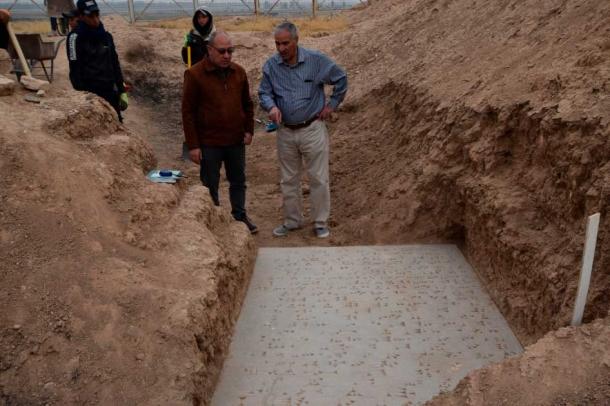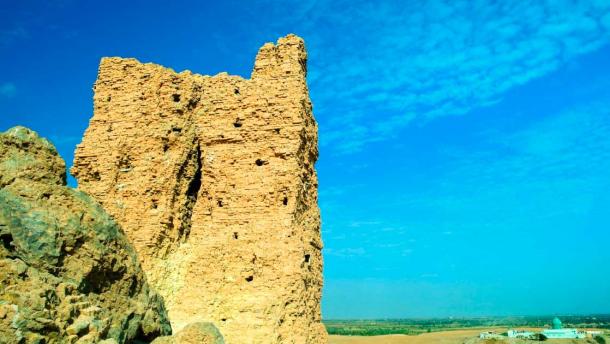
Archaeologists Salvage Inscribed Palace Door Threshold at City of Nimrud
A 6.5-foot (2 meters)-high threshold stone from the 9th and 8th century BC has been unearthed by archaeologists at the ancient Iraqi city of Nimrud. This is the first major excavation at the site after it was destroyed by the Islamic State (ISIS) in 2016.
Archaeologist Michael Danti is leading a team from the University of Pennsylvania that has been digging at the site since October this year. In a phone interview, he told The Art Newspaper:
“This find is significant. Not only because it survived the Babylonian siege and destruction by Isis intact but also because of its size. I’ve seen tablets that are smaller than one of the sign forms [cuneiform letters] on this slab.”
A Tale of Two Survivals
Nimrud is located 30 kilometers (20 miles) south of the city of Mosul in the Nineveh Plains in Upper Mesopotamia. It was a major city of the Assyrian Empire between approximately 1350 BC and 610 BC. Between around 883 BC and 706 BC, it served as the capital of the empire. When the Assyrian Empire fell in the late seventh century at the hands of an alliance of former subject peoples including the Babylonians, Medes, Chaldeans and Persians, Nimrud too was sacked.
The threshold belongs to the palace of the Assyrian king Adad-Nirari III who ruled from 810 BC to 783 BC. Remarkably, the Babylonian assault was not the only destruction it has survived.

Dr. Ali A. Yassin al-Jabouri and Representative Fadhel Mohamad examining the recently uncovered inscribed door sill in the palace of Assyrian king Adad-Nerari (811–783 BC) at Nimrud. (Michael Danti)
In 2015, ISIS announced plans to raze the excavated ancient site because of its “unIslamic” Assyrian character. It carried out several attacks at the site, using bulldozers to reduce the ziggurat, the stepped pyramidal towers characteristic of major Mesopotamian cities, and using the rubble to bury surrounding buildings. It also used barrel bombs to blow up statues. It was a pretty thorough job and when Iraqi forces retook the site in November 2016, they reported that 90 per cent of the excavated city had been decimated.

Ziggurat Bur Nimrud at Nimrud ancient city, Iraq. (homocosmicos/Adobe Stock)
“Forensic” Archaeology
According to ARTnews, the Adad-Nirari palace was first excavated in the 1840s by British archaeologist Austen Henry Layard. Since then, many similar slabs inscribed with a list of the king’s ancestors have been found.
Danti says that Layard found two such slabs during his excavations. One of these he shipped to the British Museum where it is still on display, while the other was left at the site. This was probably reburied under the collapse of the high-walled mud-brick palace during the sack by ISIS and is probably what the University of Pennsylvania team has recently dug up.
It was like “forensic archaeology. We had to re-excavate the old excavations,” Danti told the Art Newspaper. His team also discovered the pit of the other slab dug up and relocated to the British Museum by Layard. “We saw the evidence of what had been taken away preserved under new ruins. At times, it felt like we were excavating the history of 19th-century archaeology.”
Danti had read Layard’s Victorian-era books of popular archaeology and travel as a young student and had moments of epiphany during the dig when it flashed on him, “Wow, this is on page 14 of his book.”
Piecing Together a Jigsaw Puzzle
The Babylonians destroyed many of the mud-brick constructions of the Assyrians not only at Nimrud but many other sites in Mesopotamia. Iraqi antiquities authorities reconstructed many of the ruins, often adding fallen upper floors, in the mid-20th century in preservation efforts. ISIS impartially spared neither the ancient remains nor the modern reconstructions. Employing modern tools of destruction, they were able to wreak sweeping havoc.
Danti and his team face the daunting task of trying to salvage original ancient elements from the ravages. And the recently recovered slab is a miracle discovery in these circumstances. Danti said, “Isis might well have been aware of its existence and yet it was so well preserved.”
The team is now working to reconstruct the temple of Ishtar located next to the ziggurat. Isis had destroyed its majestic entrance. Danti is also hoping to learn more about Queen Sammuramat (later known as Semiramis), the mother of King Adad-Nirari III, from the excavations of the palace. She was extraordinarily powerful for an Assyrian queen, accompanying her son on military expeditions and her name figuring in cuneiform documents of the period.
So far, only a small portion of the palace has been excavated and several fragments of sculptures and other artifacts have been unearthed. Just a while ago, parts of a stone box that carried a door post invoking divine protection, were found. The box may have been destroyed in the Babylonian siege or in the ISIS attacks. The parts are scattered around the palace and are being pieced together “like a jigsaw puzzle”.
Top image: A door sill from the palace of King Adad-Nirari III, at Nimrud. Source: Michael Danti/
By Sahir Pandey
References
Ditmars, H. 2022. First major dig in ancient Iraqi city since Isis destruction unearths ‘significant’ palace door sill. Available at: https://www.theartnewspaper.com/2022/12/07/first-major-dig-in-ancient-iraqi-city-since-isis-destruction-unearths-significant-palace-door-sill.
Ho, K.K. 2022. Archaeologists Uncover ‘Significant’ Palace Door Threshold in Ancient Iraqi City of Nimrud During Major Recovery Dig. Available at: https://www.artnews.com/art-news/news/archaeologists-palace-door-ancient-iraq-city-nimrud-university-pennsylvania-1234649708/.
















Comments
"In 2015, ISIS announced plans to raze the excavated ancient site because of its “unIslamic” Assyrian character. It carried out several attacks at the site, using bulldozers to reduce the ziggurat, the stepped pyramidal towers characteristic of major Mesopotamian cities, and using the rubble to bury surrounding buildings."
If you could 'follow the money' and the flow of valuable antiquities, you might better understand what Isis is really all about. Destroying the truth of history, and/or facilitating its devious privatization?
But obviously, when mud bricks are laid overtop precise cut stones of broken megalith foundations, you know the mud brick layers came much later, and just resettled the ruins. So who cut those stones and when?
Nobody gets paid to tell the truth.